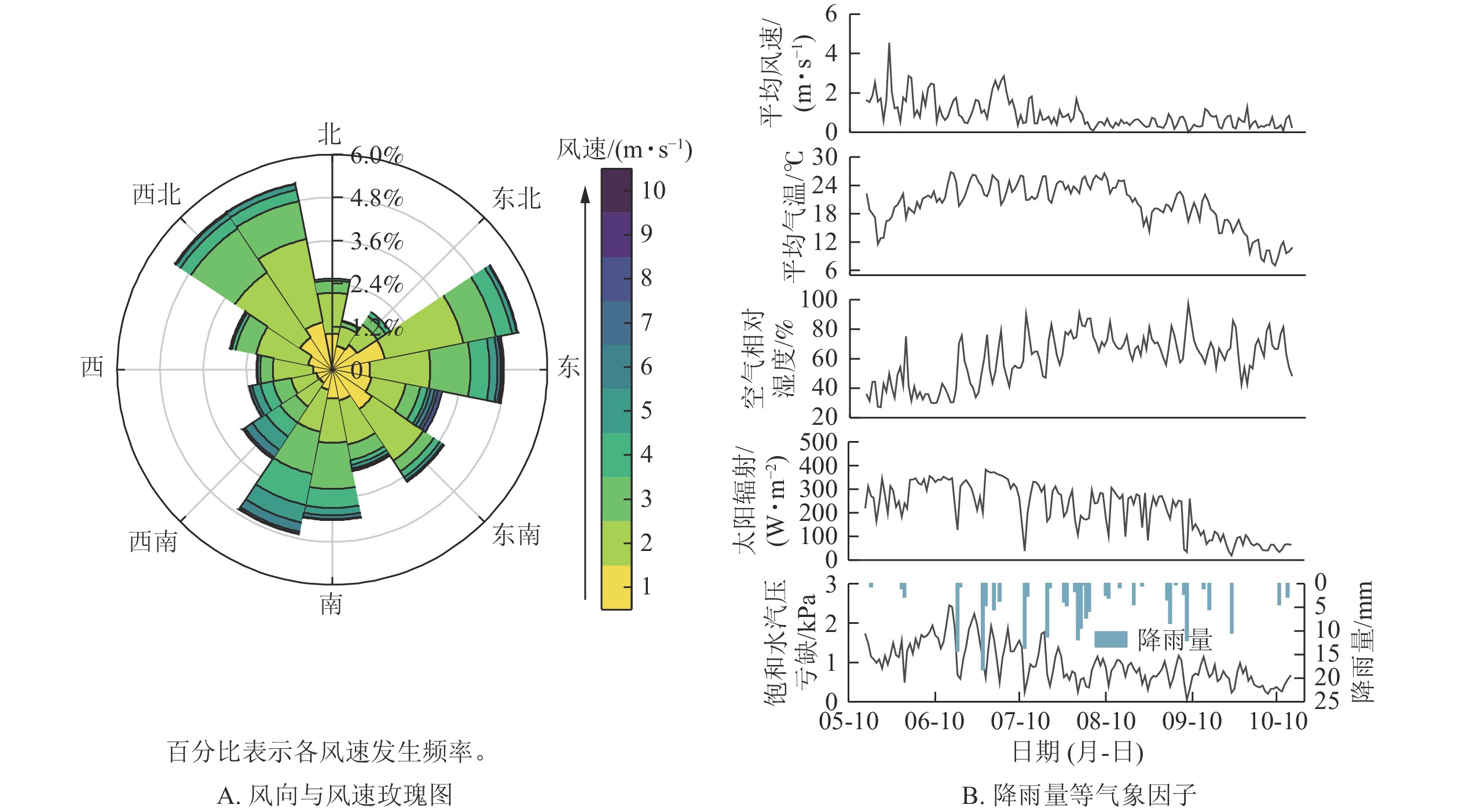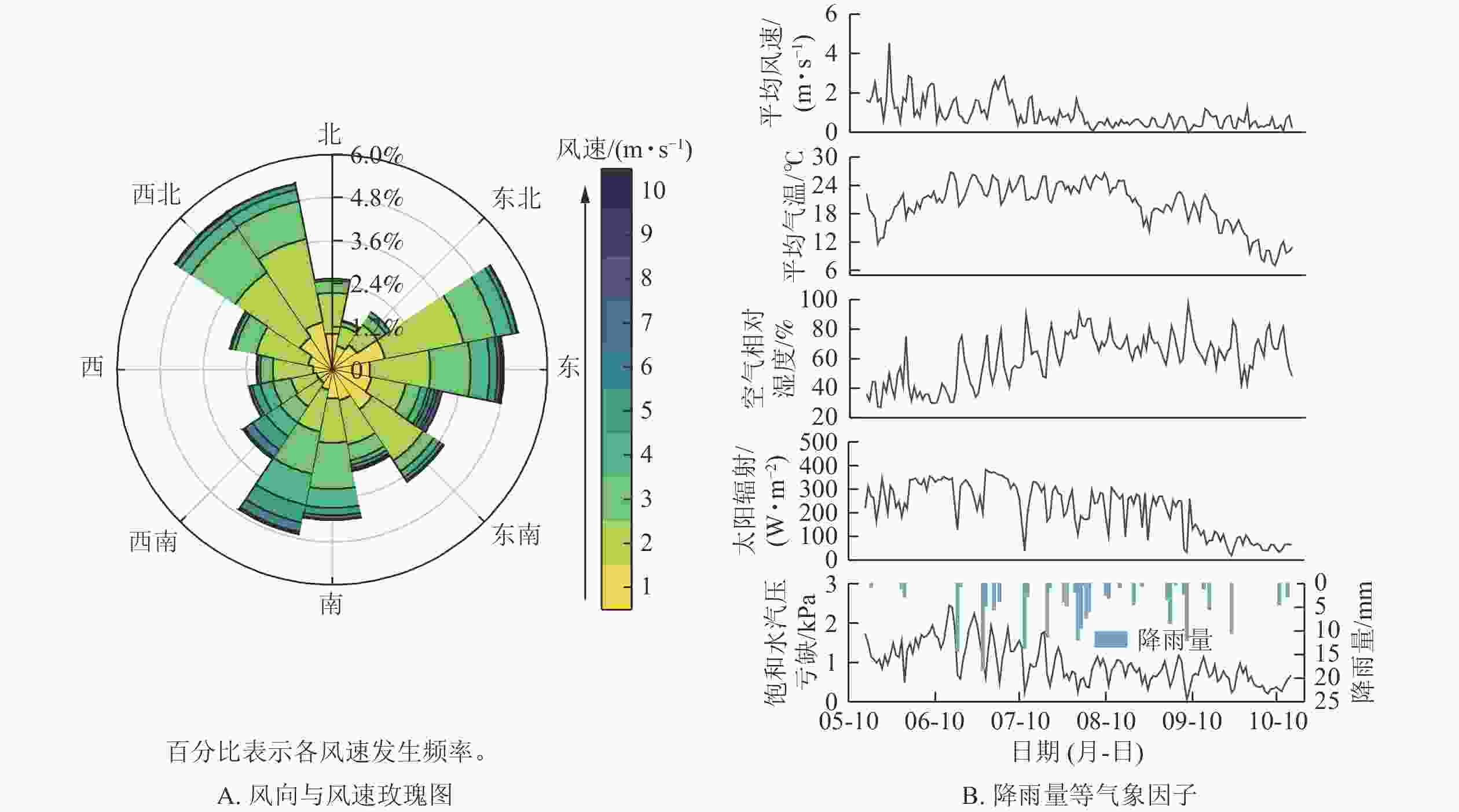-
中国荒漠化土地面积为262.2万 km2,占国土面积的27.4%。自20世纪70年代以来,中国相继启动了“三北”防护林工程体系建设、京津风沙源治理、水土流失综合治理等重点生态工程。中国已成为全球森林资源增长最快、生态治理成效最显著的国家[1]。库布齐沙漠人工林是“三北”防护林体系的重要组成部分。尽管可以通过建设人工林治理库布齐沙漠,但不适度的人工植被建设易导致林水矛盾激化,影响人工林的稳定发展[2−3]。基于此,研究干旱半干旱地区林地树种耗水规律尤为重要。沙柳Salix psammophila属于杨柳科Salicaceae落叶灌木,多分布于中国西北部干旱、半干旱地区,具有耐干旱、生长迅速、萌蘖能力强、抗风沙及耐盐碱等特点,成为“三北”防护林的首选树种之一。以往研究表明:由于植物在长期生长过程中依赖和适应外界环境变化,其蒸腾耗水特点的变化具有明显的环境水分依赖性[4−5]。因此,迫切需要了解环境水分传输对于沙柳蒸腾耗水的影响机制,以提高干旱半干旱地区植被建设中的林木质量并避免林木资源流失。
99.8%以上的植物蒸腾耗水来自树干液流[6]。植物液流通常被作为定量描述植物体内水分状况的指标,表征植物体内水分传输变化特征,反映植物的水分利用策略[7],揭示植物对周围环境变化的适应能力。液流速率可以较为准确地描述单木蒸腾耗水过程[8]。大气、土壤作为主要环境因素驱动或制约着水分传输[9]。土壤水分是植物根系吸水的主要来源,通常用土壤含水量与土壤水势来描述土壤水分状况[10]。降雨量是衡量大气水分特征的重要指标之一,它直接影响着大气中的水蒸气含量和相对湿度[11]。曾针对毛乌素沙地、河套地区、乌兰布和沙漠等干旱半干旱地区开展了沙柳及其他灌木液流速率的研究,发现液流特征主要受气象因素、土壤水分因素和生物学结构因素的影响[11−14],然而,已有研究鲜有报道干旱半干旱环境中沙柳不同基径等级枝条的液流速率对气象因子的响应规律,更少有研究揭示降雨驱动或制约沙柳蒸腾耗水及土壤水分传输的重要作用。因此,本研究选择库布齐沙漠典型沙柳人工林为研究对象,对沙柳液流速率、降雨情况、土壤水势及气象因子进行连续同步监测,研究沙柳不同基径等级枝条的液流速率动态变化规律,从而探究沙柳在生长季响应环境因子尤其是降雨和土壤水分变化过程中的蒸腾耗水控制策略,旨在为理解沙生灌木在季节性干旱下的耗水特征提供理论参考,并为干旱半干旱地区人工林的可持续发展提供依据。
-
研究区位于内蒙古自治区鄂尔多斯市达拉特旗吉格斯太镇沙柳国家种质资源库(40°14′24″N,110°39′14″E),平均海拔为1 128 m。研究区属于温带大陆性季风气候,年平均气温为6.1~7.2 ℃,年平均降雨量为297.3 mm,年均日照时数约3 000 h。土壤类型主要为草甸风沙土,土壤质地以砂土和壤土为主。人工林树种主要为沙柳。
-
2023年5月15日—10月15日,根据研究区沙柳基径(D)分布频率,将基径分为4个径级(基径6~8、8~10、10~12、>12 mm,下限排除法)。由于研究区坡度存在差异,为了保证被测对象具有代表性,在研究区右侧、中部与左侧各选取3株生长状况相似的3年生沙柳,选择不同径级沙柳枝条共12枝,即3组重复。采用基于茎热平衡法(SHB)的植物液流计(EMS 62,20通道),对生长季内沙柳枝条液流动态进行监测,传感器安装于距地表45 cm处沙柳枝条上。采用Mini32数据采集器进行数据采集,采集时间间隔为10 s,并存储为10 min的平均值。根据公式(1)计算平均液流速率Q(g·h−1) [15]。
式(1)中:Pw为热输入功率(W),ΔT为测量点的温度差(K),C为水的比热容(J·kg−1·K−1),Z为测量点的热损失系数(W·K−1)。
-
采用HOBO U30小型气象站,连续监测太阳辐射(R,W·m−2)、气温(Ta,℃)、空气相对湿度(HR,%)、风速(Vw,m·s−1)、风向(WDIR)、降雨量(P,mm)等气象因子。参考综合反映气温与相对湿度的协同效应,选择饱和水汽压差(DVP,kPa)进行评价。公式见文献[15]。
-
在研究区右侧、中部与左侧所选的沙柳样株附近各随机选取1块样地,依次标号为1号样地、2号样地和3号样地,在每个样地内分别随机设置3个土壤水势测量点(共9个)。采用TEROS 21土壤水势传感器与ZL6数据采集器连续监测各测量点土壤水势和土壤温度,监测深度为10、20、40、60及80 cm。隔10 min记录1次数据。气象因子、沙柳液流和土壤水势监测时间同步。
-
运用Excel 2021整理统计沙柳液流速率、气象因子及土壤水势等数据, 采用SPSS 26.0 对数据进行单因素方差分析(ANOVA)以及显著性检验,显著性水平为0.05,并进行通径分析、主成分分析及逐步回归分析,利用Origin 2021对其他数据进行处理和制图。
-
由图1可见:研究期内,风向以西北风、东北偏东风及东风为主,静风占比约44%。风速呈逐渐下降趋势,7月前风速为2~5 m·s−1,7月后风速为2 m·s−1以下。Ta、HR与DVP总体均呈先升高后降低的趋势。5—8月太阳辐射强度处于较高值且相差较小,9—10月下降较多。降雨主要集中于6—7月,日最大降雨量发生于6月底。
-
土壤水势随时间变化规律如图2所示,1、2和3块样地水势变化规律相似,总体呈降低趋势。各样地土壤水势均在5月最高,约为−1.0 kPa,之后土壤水势开始逐渐降低,并于7—8月出现小幅上升, 9—10月又继续降低。
-
如表1所示:研究期间,整个生长季各样地在10 cm土层土壤最为干旱,水势显著小于其他土层(P<0.05);除1号样地外,20 cm土壤次之,且40、60和80 cm土壤湿润程度显著高于其他土层(P<0.05)。此外,20 cm土层土壤水势更接近各土层水势均值。
样地号 土层/cm 土壤水势/kPa 样地号 土层/cm 土壤水势/kPa 最大值 最小值 均值 标准差 最大值 最小值 均值 标准差 1号 10 −0.442 −6.021 −2.525 e 1.592 2号 60 −0.098 −0.200 −0.107 a 0.028 20 −0.280 −1.590 −0.574 b 0.299 80 −0.200 −0.500 −0.216 a 0.051 40 −0.300 −5.320 −1.309 d 1.401 3号 10 −0.284 −345.408 −53.757 c 91.449 60 −0.098 −0.200 −0.104 a 0.021 20 −0.098 −38.295 −7.239 b 10.839 80 −0.100 −0.490 −0.177 a 0.070 40 −0.100 −5.200 −1.133 a 1.638 2号 10 −0.496 −10.319 −5.407 d 2.888 60 −0.100 −0.400 −0.195 a 0.095 20 −0.200 −5.677 −2.271 c 1.855 80 −0.098 −0.100 −0.098 a 0.001 40 −0.100 −1.168 −0.297 a 0.310 说明:均值后不同小写字母表示差异显著(P<0.05)。 Table 1. Statistical description and significant difference test of soil water potential
-
沙柳各径级液流速率呈现出明显的季节变化(图3)。在试验期间,沙柳液流速率从大到小依次为6、7、5、8、9、10月,其中径级10~12与>12 mm的枝条此规律较为明显。在5、7和8月,径级6~8 mm沙柳液流速率总体上均呈“单峰”型曲线,6月液流速率呈“双峰”型曲线,中午存在轻微“午休”现象,而径级6~8 mm沙柳液流速率在9和10月呈现先下降后上升的趋势。从沙柳液流速率日变化来看,除9和10月外,一般在每日11:00—15:00达到峰值。液流起变时间随着月份推移逐渐推迟,止变时间各月几乎一致。径级8~10、10~12和>12 mm沙柳液流速率在5—9月呈“单峰”型曲线,10月呈“U”字型曲线。径级8~10与10~12 mm液流速率在5—7月、9—10月的起变和止变时间基本一致,8月液流起变时间推迟2 h,止变时间提前1 h;径级>12 mm液流起变时间随月份推移逐渐推迟,6和7月相较于其他月份止变时间推迟1 h左右。
-
选取发生在 6—8月的9次具有代表性的降雨事件(表2),分析不同降雨量、降雨时长和降雨强度下沙柳液流对降雨事件的响应。
降雨事件 降雨量/mm 持续时间/h 降雨强度/(mm·h−1) 降雨事件 降雨量/mm 持续时间/h 降雨强度/(mm·h−1) 最小值 最大值 均值 最小值 最大值 均值 A 14.4 9 0.4 4.0 1.6 F 10.8 8 0.2 4.2 1.5 B 18.2 5 0.4 11.2 3.6 G 9.4 2 3.2 6.2 4.7 C 3.7 6 0.1 1.0 0.6 H 5.8 5 0.2 3.6 1.2 D 13.6 14 0.2 3.6 1.0 I 7.2 5 0.2 2.4 1.4 E 4.6 4 0.2 3.8 1.2 Table 2. Characteristics of different rainfall events
降雨事件A~I发生时,各径级沙柳枝条液流速率日动态特征如图4。A事件总降雨量为14.4 mm,各径级液流速率呈“双峰”型曲线,6:00为起变时间,8:00达到第1峰值,11:00达到第2峰值。B事件径级6~8与8~10 mm沙柳液流速率呈“双峰”型曲线,径级10~12与>12 mm沙柳液流速率呈“多峰”型曲线。C事件液流速率呈“单峰”型曲线。D事件、E事件与G事件各径级沙柳液流速率均呈“双峰”型曲线。F事件13:00和19:00分别为液流起变时间和止变时间。H事件各径级沙柳液流速率呈“单峰”型曲线。I事件降雨开始于16:00,各径级液流速率呈“双峰”型曲线。
降雨事件A~I发生时,各径级沙柳枝条当日累计液流量如图5。各降雨事件的沙柳日累计液流量均随枝条径级增大而增加,且径级>12 mm日累计液流量大都显著高于其他径级。降雨量为10 mm以上的降雨事件A、B、D和F的各径级日累计液流量总和平均值为2 428.3 g·d−1,降雨量为10 mm以下的降雨事件C、E、G、H和I的各径级日累计液流量总和平均值为2 526.2 g·d−1。
-
不同径级沙柳液流速率与各土层土壤水势大都在0.05水平上存在显著正相关(图6)。其中,径级6~8、8~10和10~12 mm沙柳枝条液流速率均与20 cm土层土壤水势(PSW20)和40 cm土层土壤水势(PSW40)呈显著正相关(P<0.05);此外径级10~12 mm还与10 cm土层土壤水势(PSW10)和60 cm土层土壤水势(PSW60)呈显著正相关(P<0.05),而径级>12 mm仅与80 cm土层土壤水势(PSW80)呈显著正相关(P<0.05)。综上,径级较小的沙柳枝条液流速率与PSW20和PSW40相关性更高,而径级较大的枝条液流速率则与PSW60和PSW80相关性更高。
通过沙柳枝条各径级液流速率与土壤水势的通径分析(表3)可知:土壤水势对径级6~8和8~10 mm沙柳液流速率的直接作用从大到小依次为PSW40、PSW60、PSW10、PSW80、PSW20。对径级10~12 mm沙柳液流速率的直接作用从大到小依次为PSW40、PSW10、PSW20、PSW60、P SW 80;对径级>12 mm沙柳液流速率的直接作用从大到小依次为PSW80、PSW60、PSW40、PSW10、PSW20。说明PSW40对径级6~8、8~10和10~12 mm沙柳液流速率的直接作用最大,PSW80对径级>12 mm沙柳液流速率的直接作用最大。PSW20的间接通径系数之和远大于直接通径系数,所以PSW20主要是通过PSW40与PSW60的共同作用影响沙柳液流。
径级/mm 指标 直接通径系数 间接通径系数 PSW10 PSW20 PSW40 PSW60 PSW80 总计 6~8 PSW10 0.393 - 0.275 0.362 0.329 0.146 1.113 PSW20 0.196 0.137 - 0.171 0.145 0.083 0.537 PSW40 2.108 1.944 1.842 - 1.927 1.079 6.792 PSW60 1.235 1.035 0.916 1.129 - 0.903 3.983 PSW80 0.359 0.133 0.153 0.184 0.262 - 0.732 8~10 PSW10 0.656 - 0.460 0.605 0.550 0.243 1.858 PSW20 0.020 0.014 - 0.017 0.015 0.009 0.055 PSW40 2.169 2.000 1.896 - 1.982 1.111 6.989 PSW60 0.956 0.801 0.709 0.874 - 0.699 3.083 PSW80 0.087 0.032 0.037 0.045 0.064 - 0.177 10~12 PSW10 0.192 - 0.135 0.177 0.161 0.071 0.544 PSW20 0.095 0.067 - 0.083 0.070 0.040 0.260 PSW40 1.089 1.004 0.952 - 0.995 0.558 3.509 PSW60 0.031 0.026 0.023 0.028 - 0.023 0.100 PSW80 0.001 0.000 0.000 0.001 0.001 - 0.002 >12 PSW10 0.221 - 0.155 0.204 0.185 0.082 0.626 PSW20 0.036 0.025 - 0.031 0.027 0.015 0.099 PSW40 0.505 0.466 0.441 - 0.462 0.259 1.627 PSW60 0.540 0.453 0.401 0.494 - 0.395 1.742 PSW80 0.702 0.260 0.298 0.359 0.513 - 1.431 说明:-表示无此项。PSW10、PSW20、PSW40、PSW60和PSW80分别表示10、20、40、60和80 cm土层土壤水势。 Table 3. Path analysis of sap flow rate and soil water potential
-
本研究测定了降雨前后风速、气温、相对湿度、饱和水汽压差和不同土层土壤水势、土壤温度等11个指标。降雨前针对影响沙柳液流速率的环境因子采用主成分分析法共提取了3个主成分,累计方差贡献率为87.5%,分别解释了方差的42.1%、28.9%、16.5%(表4)。第一主成分主要包括20 cm土层土壤温度(Ts20)和40 cm土层土壤温度(Ts40)等因子,归为土壤蒸发需求因子。第二主成分包括饱和水汽压差、空气相对湿度和气温等因子,归为大气蒸发需求因子。第三主成分包括10 cm土层土壤水势(PSW10)与20 cm土层土壤水势(PSW20),可以归为土壤水分供给因子(图7)。
阶段 主成分 特征值 贡献率/% 累计贡献率/% 阶段 主成分 特征值 贡献率/% 累计贡献率/% 降雨前 1 42.1 42.1 42.1 降雨后 1 9.9 62.8 62.8 2 28.9 28.9 71.0 2 2.6 23.3 86.2 3 1.8 16.5 87.5 Table 4. Principal component characteristic value and contribution rates in environmental factors
降雨后,共提取了2个主成分,累积方差贡献率达86.2%,分别解释方差的62.8%、23.4%(表4)。其中第一主成分主要包含10 cm土层土壤水势(PSW10)和20 cm土层土壤水势(PSW20)等因子,归为土壤水分供给因子;第二主成分主要包含饱和水汽压差和空气相对湿度等因子,可归为大气蒸发需求因子(图7)。
由各径级沙柳液流速率与环境因子的逐步回归模型(表5)可知:降雨前沙柳液流速率与各环境因子决定系数平均为0.83,降雨后为0.71。降雨前各径级第一进入因子均为空气相对湿度,即各径级液流变化主控因子为空气相对湿度。降雨后第一进入因子为土壤因子,且径级>12 mm沙柳液流速率在降雨前与降雨后所受制约的因子数均较少。
阶段 径级/mm 回归方程 R2 P 降雨前 6~8 y=41.228−0.333HR−9.046DVP+0.511Ta 0.826 0.000 8~10 y=26.032−0.110HR+0.009R 0.811 0.000 10~12 y=84.661−0.697HR−19.646DVP+1.453Ta-1.194 Ts20 0.894 0.000 >12 y=58.655−0.264HR 0.789 0.000 降雨后 6~8 y=11.216+0.339Ts20 0.523 0.000 8~10 y=98.810+1.117PSW40+774.279PSW60 0.831 0.000 10~12 y=14.026+0.343Ts10+0.004R 0.742 0.000 >12 y=22.726+0.546Ta +0.100R 0.731 0.000 说明:y. 沙柳液流;HR. 空气相对湿度;DVP. 饱和水汽压差;Ta. 气温;R. 太阳辐射强度;Ts10. 10 cm土层土壤温度;Ts20. 20 cm土层土壤温度;PSW40. 40 cm土层土壤水势;PSW60. 60 cm土层土壤水势。 Table 5. Stepwise regression model of sap flow rate and environmental factors
-
本研究中,5—8月,各径级沙柳枝条全天液流速率均呈“单峰”或“双峰”型曲线。在干旱、半干旱区,夏季中午太阳辐射强、温度高,植物会通过关闭气孔的方式,来减少体内水分过分流失,从而降低液流,出现“午休”现象[16]。各径级沙柳枝条液流速率在9和10月出现“U”型曲线或日间液流速率低于夜间的情形,与洪光宇等[17]的研究结果不一致。这可能由于本研究区干旱加剧,并且日间低温下光合作用减弱,树木在遭遇水分等因子胁迫时,可以通过控制气孔开闭、降低叶片蒸腾、调节叶片细胞渗透势等途径来抵御干旱,其中对气孔开闭的控制最为重要,表明沙柳在一定程度上通过调控气孔开度进而控制叶片传导度来调控蒸腾[18−19]。
本研究发现:沙柳液流速率呈现出明显的季节性规律,月尺度液流速率从大到小一般为6、7、5、8、9、10月,这与郝少荣等[14]对毛乌素沙地沙柳的研究结果不完全相同。总体来说,液流速率变化都受季节降水的影响,在生长初期的旱季(5月)液流速率较小,在雨季沙柳生长旺盛,液流速率也随之增大,且在降雨事件后液流速率一般有较大波动。有学者对比了干旱季和雨季沙柳液流速率变化规律,发现春季和夏季出现的干旱对液流都有抑制作用,夏季后期降雨增多使得液流量保持较高[20]。以上结果可能是由于当环境水分较低时,沙柳通过关闭气孔等方式降低液流速率,减少自身需水量,提高水分利用率,从而适应环境的干旱胁迫[18]。其中,更高径级(>12 mm) 的沙柳液流速率较同生境8~10、10~12和6~8 mm的沙柳液流速率更高,且变化幅度更大,说明径级更高的枝条具有更好的环境适应性。本研究中各径级液流速率起变时间在7月之后随着月份的推移逐渐推迟,而液流结束时间各月几乎一致。一方面,可能由于液流清晨起变相较于下午止变更容易受到温度和光照强度等因素影响;另一方面,植物在生长季初期相较于后期代谢旺盛,对水分需求量更大,从而使得后期液流速率的起变时间推迟[21]。
-
本研究中,10~40 cm土层土壤水势较小且变化剧烈,60与80 cm土层土壤水势较大且较稳定,基本达到饱和。这与张益等[22]研究发现樟子松Pinus sylvestris var. mongholica林下土壤水势变化规律相似。半干旱区蒸发量远大于降雨量。由于沙地土壤特性的综合作用,浅层土壤的含水量更易受气温、蒸发量和降雨等多种因素影响[23],所以10 cm土层土壤水势变化较剧烈。土壤水势变化对降雨的时空变化具有极强的依赖性[24]。由于降雨是干旱区、半干旱区土壤水分主要的补给形式之一,因此沙柳林土壤水势具有明显的时间变异性。研究期内降雨事件C和I的当日液流速率变化均呈“单峰”型曲线,可能是由于在降雨量较少的情况下,环境中的湿度相对晴天较高,植物不需要采取关闭气孔的措施来减少水分蒸发,因此不会出现类似晴天的“午休”现象。对于降雨量大于10 mm的雨天,各径级沙柳液流速率变化均呈“多峰”型曲线。各径级沙柳日累计液流量总和平均值出现下降,可能归因于降雨使植物叶片上的水分增加,增加了冠层潮湿程度,从而使蒸腾作用的强度降低[25],并且降雨还会增加土壤中的水分含量。当土壤水分充足时,植物根系更易吸收水分,减少了植物对水分的需求,导致雨后短时间内植物液流量降低[26]。
本研究中径级较小的沙柳液流速率与20和40 cm土层土壤水势相关性更高,受40 cm土层土壤水势的直接影响程度较大;而径级较大的沙柳液流速率与60和80 cm土层土壤水势相关性更高,受80 cm土层土壤水势的直接影响程度较大。这可能是由于水分吸收能力和需水量不同导致。径级较大的沙柳枝条生长所需水分更多[27],土层较深处的土壤水势较高,所以在浅层土壤水分受限时,可以获取深层土壤中的水分资源,因此,它们对较深的土壤水势变化更为敏感。
-
依据研究期内沙柳不同径级枝条液流速率均与不同土层土壤水势呈显著相关,从而考虑降雨前后土壤水势等环境因子对液流特征的影响。本研究中降雨强度大于6 mm·h−1时,液流速率会立即被抑制,其原因可能是当土壤含水量在短时间内增加至过高,据此升高的根系水势释放相应信息素,影响树木细胞的正常生理功能,损害水分运输能力,进而导致液流降低[28]。理论上,降雨通过改变气象因子和补充土壤水分影响沙柳气孔开度和根系吸水,进而促进或抑制沙柳蒸腾耗水,降雨后水蒸气的阻隔致使光照强度和气温降低,从而限制了沙柳光合速率,降低了液流速率[29]。此外,降雨前土壤蒸发需求因子与大气蒸发需求因子累计贡献率为71.0%,土壤水分供给因子贡献率仅为16.5%;降雨后土壤水分供给因子累计贡献率高达62.8%。说明降雨前液流速率主要受气象因子控制,降雨后10与20 cm土层土壤水势是影响液流速率的最重要因子。这与卢森堡等[30]研究沙棘Hippophae rhamnoides对降雨的响应结果相似。该研究认为,长期干旱降低了土壤与根系之间的水势差,从而抑制根系对土壤水分的吸收;较小降雨补充浅层土壤水分,并增加根系与土壤之间的水势差,致使沙棘液流速率主要受10与20 cm处的土壤水势影响。
-
在生长季,不同径级沙柳枝条液流速率特征具有规律性。5—8月,各径级沙柳枝条液流速率日变化均呈“单峰”或“双峰”型曲线,但9—10月易因低温及干旱出现日间液流速率低于夜间的情形,因此夜间液流的重要性不可忽视。降雨事件前后液流速率一般有较大波动,各径级沙柳枝条液流速率变化均呈“多峰”型曲线,雨后短时间内累计液流量降低。降雨前沙柳液流速率主要影响因素为土壤蒸发需求因子与大气蒸发需求因子,降雨后为土壤水分供给因子。总之,沙柳液流速率的瞬时变动和总体水平分别受气象因子和土壤供水的影响。这表明季节性干旱下沙柳不同时间尺度液流特征受不同环境因子的影响。
Response of sap flow rate in Salix psammophila plantation to soil water supply and its influencing factors
doi: 10.11833/j.issn.2095-0756.20240359
- Received Date: 2024-05-17
- Accepted Date: 2024-09-20
- Rev Recd Date: 2024-09-18
- Available Online: 2024-11-05
- Publish Date: 2025-02-20
-
Key words:
- Salix psammophila plantation /
- sap flow /
- transpiration /
- rainfall /
- soil water potential /
- diameter level
Abstract:
| Citation: | SUN Kai, LIU Wenjuan, PEI Zhiyong, et al. Response of sap flow rate in Salix psammophila plantation to soil water supply and its influencing factors[J]. Journal of Zhejiang A&F University, 2025, 42(1): 163−174 doi: 10.11833/j.issn.2095-0756.20240359 |

















 DownLoad:
DownLoad:





